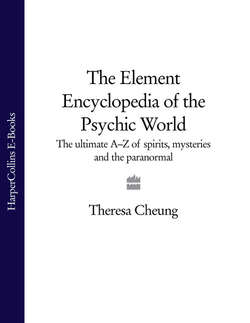Читать книгу The Element Encyclopedia of the Psychic World: The Ultimate A–Z of Spirits, Mysteries and the Paranormal - Theresa Cheung, Theresa Cheung - Страница 5
Introducing the psychic world [a very brief history]
ОглавлениеPsychic traditions have existed since the beginning of recorded history and have been present in one way or another in ancient cultures all over the world. It seems that a belief in ghosts and communication with spirits of the dead has also always been with us from our earliest beginnings.
In the ancient Middle East, psychic powers were practised by prophets and are described in the Bible’s Old Testament. The royalty of many ancient cultures used divination to seek guidance in times of war and to predict natural disasters such as drought. The Egyptians believed they could communicate with the dead and forecast future events using palmistry and dream divination. In Africa the ancient peoples used trance states to contact the spirits of their dead ancestors. The Greeks used oracles at sacred locations to give prophecies of the future and the Romans looked to the stars for messages from the invisible realm. Early American psychic practices have also been documented. The Aztecs in Mexico used astrology and oracles and Native Americans relied on advice given to them by shamans who entered deep trance-like states to contact spirits.
Although belief in ghosts was present from the very beginning of human history, the first extant report of a haunted house comes from a letter written by a Roman orator called Pliny the Younger (AD 61-112). He wrote to his patron, Lucias Sura, about a villa in Athens that nobody would rent because of a resident ghost.
The best-known psychic of the Middle Ages was a French physician called Nostradamus (1503-1566). He wrote about a thousand prophetic verses, which are still analysed today by scholars looking for references to the world’s future.
After the Middle Ages and the Renaissance, during the Age of Reason, belief in psychic powers and the paranormal waned, but it was reborn again with the help of the Spiritualist movement. The foundations of spiritualism were laid by Emanuel Swedenborg (1688-1772), who allegedly went into trances and communicated with the dead. However, it was the Fox sisters, Kate (1841-1892) and Margaretta (1838-1893), who really brought psychic phenomena to the forefront. The sisters claimed they were able to manifest spirit communication through the rappings of a peddler who had been murdered and found in the Fox home. The public were fascinated as the sisters gave public demonstrations of this psychic manifestation throughout the United States.
Even though the sisters later confessed to fraud, the Spiritualist movement was by then well underway both in the United States and in Europe. Spirit rapping gave way to séances, table-tilting, trance writing and spirit communication through a medium. Many of these techniques are still practised today by Spiritualist churches.
Perhaps the biggest influence on the advancement of psychic knowledge was that of a man called Edgar Cayce (1877-1945), who is now considered the founder of the so-called New Age movement. Cayce had remarkable psychic powers. Allegedly he could see into the future and give predictions. He could look through objects and inside the human body. He was also able to enter another person’s mind and know what that person was thinking, and sleep on a book and remember its contents.
The phenomena produced by mediums and psychics like Cayce during the height of spiritualism in the latter part of the nineteenth century quickly attracted the attention of eminent scientists and intellectuals, and the scientific investigation of alleged psychic powers, ghosts, apparitions, poltergeists and paranormal phenomena began in earnest. In 1882 the Society for Psychical Research was formed in London, and in 1885 the American Society for Psychical Research was founded in Boston. Clubs, organizations and societies dedicated to the paranormal sprung up all over the world, and as the twentieth century drew to a close the psychic world had successfully filtered into mainstream culture. It looks set to stay there.
Today we have televised séances and ghost investigations, celebrity mediums and psychics and bookshops, websites and university courses devoted to the paranormal. Over the years investigation of the paranormal has become increasingly sophisticated and precise. It isn’t about superstition and eye-witness accounts any more, but about laboratory experiments, data, theories, statistical evaluation and high technology. There are those who are keen to offer theories to prove we live in a psychic world and those who are convinced it doesn’t exist. There is a huge desire to unravel the mystery. The hotly debated question at the beginning of the twenty-first century is, are psychic phenomena real?
